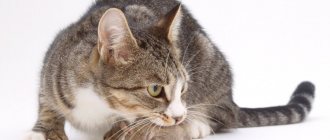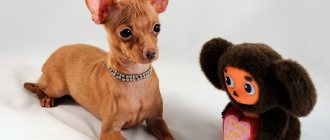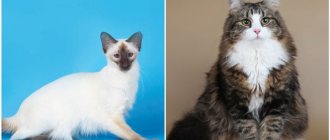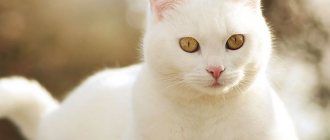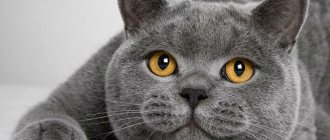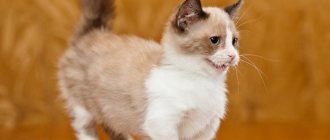Briefly about the breed
The Bengal cat is a broad-shouldered and muscular pet with a short-haired spotted or merle pattern.
The head of the Bengal is pointed, the neck is short and powerful, and the tail is of medium length.
The Bengal cat is a broad-shouldered and muscular pet.
The color of the cats resembles their leopard ancestors. The color range varies within brown shades. There are also snow and silver Bengals.
This is one of the cat breeds that lead an active lifestyle. Bengalis have developed mental abilities, inherited from their ancestors, who needed them to survive in the wild.
The paws of Bengal cats are particularly dexterous. Many representatives of the breed can easily move and carry objects, open and close doors.
During the process of domestication, the aggression inherent in their ancestors completely disappeared. Bengal cats are peaceful and playful, but they value freedom highly and are not very fond of being held.
Description of the Bengal cat breed
The Bengal cat has its own characteristics of the breed.
Dimensions and weight
The size of the cat is impressive. Bengals impress with their long, strong, slender body. Males are much larger than females. The weight of adult cats varies from 4 to 7 kg. The height of the cat is 26-32 cm.
Photo: adult Bengal cat
The small head of the Bengal cat is shaped like a wedge. The small ears are rounded at the tips and wide at the base. The tail is short and dense.
There are “wild” stripes on the muzzle, the eyes are expressive and large. The cats are smooth-haired, which makes the breed easier to care for.
The character and behavior of the Abyssinian cat is described in the article: Abyssinian cat.
Read about the most beautiful cat breeds here.
Colors
A distinctive feature of the Bengal cat is its color.
Golden color – Brown tabby
From a genetic point of view, this color is black. The cat has an unusual undercoat that makes it brown.
The color of the animal was originally black and this can only be understood by several places on the pet’s body: the paw pads and the tip of the tail retained the black color. On the back of the animal the fur is slightly darker.
Such cats are the most common among breeders of the breed. The distinct lines may be black or range in color from tan to dark chestnut.
The tip of the nose must be brick-colored, and the pads of the paws, the tip of the tail, and the rim of the eyes must be black.
Eyes can be gold, green, copper, brown or bronze.
Photo: brown tabby – a serious purebred cat
Silver color – Silver tabby
Silver-white color is the main one. Each hair has a stripe of bright black or ash-gray color. The outlines of the nose, lips and eyes are painted in intense black.
Contrast with highlighted eyes, chin, lips and nose. In pure breed there is a silver color, but slight darkening on the back is allowed.
Why monitor the development of newborn kittens?
The weight of kittens is an indicator of their health.
Kittens can lose weight for the following reasons:
- congenital and acquired diseases;
- parasite infection;
- improper diet;
- breed or genetic abnormalities.
In order to timely identify deviations from the norm of nutrition and possible diseases, the owner of a Bengal cat is recommended to compare the kitten’s weight with the norms daily during the first weeks of life. In the future, the frequency of weighing can be reduced to 2 times a week.
Be sure to read:
Cats that look like a leopard: cats with brindle and leopard coats
Kitten weight table by age
The weight of a cat at each age should correspond to the norm:
| Age | Average breed weight |
| First week of life | 0.07-0.12 kg |
| 1 month | 0.4-0.5 kg |
| 2-3 months | 0.5-2.4 kg |
| 4-5 months | 2.7-3.6 kg |
| 5-6 months | 2.9-3.9 kg |
| 7 months | 4 kg |
| 8-9 months | 4.1-6 kg |
| 10 months - 1 year | 4.2-6 kg |
Growth characteristics of Bengal kittens
Bengal kittens are born weighing from 70 to 120 g. By the first week of life, their weight doubles, and by the end of the month it reaches approximately 500 g. At the end of the first month, the process of weight gain gradually slows down.
Bengal kittens are born weighing from 70 to 120 g.
By 7-9 months, cats stop gaining weight, and cats continue to grow slowly until they are 2 years old.
According to the standards set by the World Cat Federation (WCF), the weight of a female should be 5 kg, and a male should be 8 kg. Body length varies from half a meter to 90 cm.
The weight of representatives of this breed largely depends on the genetic characteristics of the parents and can often exceed the average.
What are the dimensions and weight of a Bengal cat?
The Bengal cat breed is very beautiful. This is a mixture of domestic and wild cat. Therefore, it is not surprising that in one creature the external wild color and the domestic grace of a pet have developed (see what a Bengal domestic cat looks like).
This cat has a very muscular and large body, which is supported by sinewy legs. That’s why their standard sizes always have rather large numbers (see photos of large-sized cat breeds).
Naturally, females differ in appearance from males. Their difference in weight and, accordingly, in size immediately catches your eye. A male who has outgrown puberty is twice as old as a cat.
If the body of a large male reaches 90 centimeters, then his body weight should be 8 kilograms. Whereas the difference with a cat will be 3 kilograms. As we can see, Bengals have a long body, which, by the way, is graceful, which is how they differ from other cat breeds.
How to Help Your Bengal Kitten Gain Maximum Weight
To control the development of the Bengal, you should follow simple rules:
- During the first two weeks of life, monitor the kitten's weight daily. Then the procedure can be carried out 2 times a week.
- Provide your nursing cat with high-quality and balanced nutrition. If kittens on natural feeding do not gain weight well, then the amount of proteins and vitamins in the cat’s diet should be increased.
- If a kitten loses weight, it is recommended to feed it with special food for kittens.
Diseases in cats that lead to obesity
The cause of extra pounds may not only be overeating.
Obesity is the scourge of many cats
The following diseases are often triggers of obesity:
- hypothyroidism (hormonal disease of the thyroid gland);
- insulinoma (pancreatic tumor);
- hypothalamic disorders;
- problems with the pituitary gland, the organ responsible for the production of hormones that affect metabolism.
Thus, everyone who wants to raise a healthy pet is obliged to control the weight of the animal. It is also important to dose the cat’s food so that he does not suffer from obesity later.
Wild leopard cats combine the predatory grace and gentle nature of an ordinary pet. The work of breeders makes it possible to keep the animal at home, without suffering either the animal or the owner.
Bengals are notable for their loyal nature and love of play. They are suitable for a large family, where they can receive special attention. This breed is endowed with a strong, large body and sinewy paws. Therefore, the standard sizes and weight of a Bengal cat differ in many ways from other breeds.
Small domestic leopards can be recognized by the following standards:
- neat wedge-shaped head;
- eyes are set wide apart and can be of any shade (blue only with white color);
- small, rounded ears;
- powerful, short neck of equal width with transition zones;
- large bones and elongated hind legs;
- the front paws are particularly dexterous (can carry objects);
- a dense tail of medium length, tapering at a black tip.
The main feature of Bengals is their color and coat structure. Short but dense shiny hairs give the coat a rich look and make it pleasant to the touch . Long hair in this breed is rejected.
Exotic spots on the body indicate wild genes. Bengal cat kittens may lose them for a while as they grow up (up to a year). This phenomenon is absolutely normal and is not a defect.
The main colors include:
- spotted, characterized by small spots randomly scattered throughout the body;
- rosette, combining spots of various sizes and stripes extending from them;
- marbled, practically or completely eliminating spotting.
There is a silver snow bengal that can have any of the above colors.
Domestic Bengals have impressive sizes: males can reach 8 kg, females - 5-6 kg. The total length of the body is approximately 90 cm, and the height at the withers is 41 cm.
Bengal kittens grow quickly. By the end of the first week, they become 2 times larger than the parameters obtained at birth.
The size and weight of a Bengal cat depend on the parents involved in creating the offspring. Approximate indicators of kitten development by month can be found in the table:
Age (month)
Weight, kg)
The following points are worth remembering:
- initial weight changes over the course of a week;
- a one-month-old kitten should weigh about half a kilo;
- after 1 month of life and up to 3 months, growth is slow;
- when you step over 1 kilogram, growth will accelerate;
- a new slowdown will occur in the 7th - 9th month and will finally stop in females;
- males continue to increase their parameters up to 2 years.
If deviations from the norm are observed, it is worth consulting with a specialist and analyzing the animal’s nutrition.
The large weight and height of Bengal cats is already inherent in nature itself. In order for it to meet the standards throughout life, you need to follow some rules.
Proper care of Bengal kittens:
- The kitten's weight must be recorded every day. This will help track how many grams he has gained. Fourteen days after birth, you can no longer monitor your weight so often; once every 3 days is enough.
- If kittens that have not been weaned from the cat slowly gain weight, you should pay attention to the mother’s diet. It must be of high quality and balanced. For normal weight gain in kittens, it is necessary to add more protein and vitamins to the cat’s menu.
- If this measure does not produce results, the kitten should be shown to a specialist to rule out the presence of diseases.
- If the baby loses weight, you can feed it with industrially produced compounds specially designed for kittens of this breed.
Causes of weight loss in adulthood:
- Changing your diet. A Bengal may not like new food. It is recommended to choose food of the same brand. If the cat is on a natural diet, each new product should be introduced gradually, in small quantities.
- Parasites can cause your cat to lose weight. It is imperative to prevent infection with worms and fleas.
- Weight loss can be a consequence of any disease. If changing the menu and treating for worms does not help, you need to consult a veterinarian.
What to do if your Bengal begins to gain weight poorly
Having noticed deviations in weight gain, you should determine the reasons for this.
Bengals are one of the cat breeds that lead an active lifestyle.
A few common reasons:
- Poor nutrition. Underweight occurs if the kitten is malnourished or does not receive enough nutritional components. Make sure that the kitten eats 6 times a day and has constant access to clean drinking water.
- Refusal to eat. This problem especially often occurs among owners who purchased a kitten from a breeder. The pet may already be accustomed to a certain food and refuse to eat a new one. In this case, you should transfer the kitten to a new food gradually.
- Stress. Sudden changes in environment and other factors can provoke stress. When stressed, kittens may refuse to eat. As a rule, adaptation takes from a couple of days to a week, after which the pet begins to eat normally and gain weight again.
- Diseases. If a Bengal eats properly, but still does not gain weight well, this may indicate diseases of the digestive system. In this case, you should definitely show your pet to a veterinarian.
- Parasites. Weight loss may indicate the presence of worms. Prevention against parasites should be carried out every six months starting from three weeks of age. For kittens, a suspension is used: it is easier to administer into the body.
Be sure to read:
Description of the snowshoe cat breed - snow shoe. Character, color, where to buy kittens
Care and maintenance
Caring for a Bengal cat is very simple. They don't need to be constantly brushed. A Bengal kitten does not require special care. If they are raised correctly, they don’t tear wallpaper or shit anywhere.
It's quite easy to train a Bengal to litter; they love to bury. It is enough just to show the place and accustom it to the filler. The animal hardly sheds.
Health
Diseases of Bengal cats are no different from other breeds. The only disease to which these animals are susceptible is hypertrophic cardiomyopathy. The disease is inherited. If your pet gets sick, you will need medical attention.
Another condition that affects Bengals is dry nose. It usually manifests itself in babies - the kitten becomes lethargic. It is best to treat dry nose syndrome when the first symptoms occur.
How long do Bengal cats live?
The lifespan of Bengal cats depends on their lifestyle and diet. Therefore, they need a special diet. It is best to feed your Bengal with special food designed for this breed. Bengal cats live 10–12 years at home.
Nutrition
The right diet for Bengal cats is the key to beautiful fur and a cheerful character. You should also remember that this breed has a very delicate stomach, so you can’t feed them just anything. It is better if the Bengal cat eats special soft canned food; you can also give dry food. The food must be fresh. The animal must have constant access to water.
Purchase. How to choose the right Bengal kitten
A huge role in the health of a kitten is played by its pedigree. You shouldn't expect a large pet from oversized parents.
It should also be taken into account that if the parents are quite large in size, and the kitten does not meet the weight standards for its age, then, presumably, it is from a large litter.
In the womb and during natural feeding, kittens from a large litter may not have received enough vitamins and other useful substances, therefore, there is a risk that their health will be poor.
A huge role in a kitten’s health is played by its pedigree.
When buying kittens, they examine the eyes and inner surface of the ear:
- Eyes should be clean, without signs of conjunctivitis. The eye color of a Bengal kitten is fixed by the age of 1.5-2 years. Until this age, the color may change from yellowish to green and blue. According to the standard, the Snow Bengal must have blue eyes.
- The inner surface of the ear should be clean; inflammation may indicate the presence of ear mites.
The kitten's color may seem uncharacteristic of the breed, but this is normal.
Bengals acquire their adult coloration when they reach two months of age.
You should not buy a Bengal from your own hands: there is a risk of purchasing a sick animal with deviations from breed standards.
How to choose a kitten
The Bengal girl inherited from her wild ancestor the ability to change color. The phenomenon is called phasing. This is a certain camouflage necessary in the wild.
Bengal kittens are born with a very beautiful leopard color. However, at the age of 3-4 weeks they acquire a gray color and look inconspicuous. The phasing period lasts until the kitten is 3-5 months old, and then it becomes beautiful again. Therefore, it is difficult to determine the class of a pet. And potential buyers are afraid that it is a fake. Bengals acquire their final pattern and color by 10-14 months.
You can choose a kitten by visiting the nursery or reserve it using a photo.
The best time to take your baby home is 3.5 months. Firstly, vaccinations have been done, and secondly, it is easier for the kitten psychologically. The mother begins to move away from her kittens, littermates turn into competitors.
Cost of a Bengal kitten
The Bengal cat breed is considered the most expensive in the world. The main reason is the difficulty of breeding.
The price depends on the nursery, the quality of the animal, and the region.
- A 3-month-old Bengal kitten of classic spotted color, not for breeding or with a cosmetic defect, costs from 30 to 50 thousand rubles.
- A representative of the breed class (permissible for breeding) costs from 50 to 100 thousand rubles.
- The cost of a breeding pet starts from 100 thousand rubles. Animals from abroad cost up to $7,000.
You cannot buy a Bengal at the market or pet store. The best place to purchase is at an exhibition. Even if you can’t make a purchase, you can learn everything about Bengal cats, what purebred animals should look like, get information about nurseries, see their best representatives, and trace the origin of the animals.

